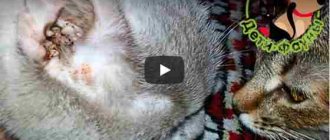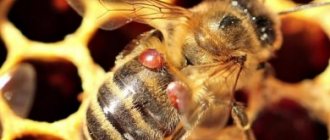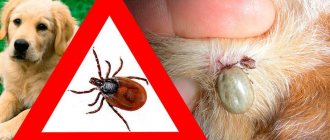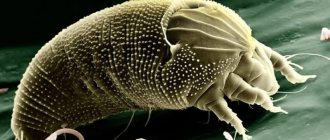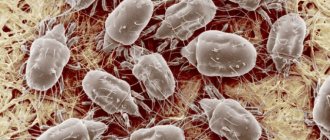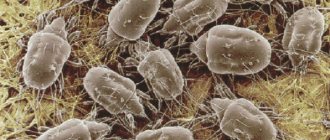Reproduction
When breeding, female grape leaf mites lay eggs.
At the same time, males emerge from uninseminated eggs, and both males and females emerge from inseminated eggs. In the tick development cycle, there are females of two species:
- summer - protogynous, ensuring reproduction during the growing season;
- winter - deuterogenous, adapted to survive in winter conditions and lay eggs in the spring.
Ticks
There are several types of mites that attack fruit trees, their description:
- The grape spider is an arthropod insect of a yellowish-herbaceous color, 0.4-0.6 mm in size. It actively develops at temperatures above +15°, which does not drop for several days. Within a week it begins to destroy the greenery. It is almost impossible to notice spider mites. Damage to bushes is determined by a whitish-canary-like bloom and lightened spots on the greenery. The plates dry out and the plant dies.
- Felt - 0.2 mm. Sunken spots covered with snow-white fluff form on the greenery. They become brown and lumpy. This leads to a lag in the development of bunches, greenery, shoots, and tendrils. Soon the grapes die. The itch gets in through seedlings and neighboring bushes.
- Grape leaf - no more than 0.15 mm. In winter, it feeds on the kidneys, which leads to their damage. Weakened and twisted shoots appear from them, which is often mistaken for the consequences of frost. Due to the lesion, the leaves become wrinkled and deformed, appearing to be cut by a blade.
What can be treated, the most effective ways:
- Before swelling of the buds, treat with a 5% lime-sulfur solution strictly according to the instructions.
- If symptoms are detected, spray the foliage with Bi-58, Actellik, Neoron, Omite. The treatment is repeated twice or thrice with an interval of 1.5-2 weeks.
- Spray the trees with a 2% solution of Fozalon and Karate throughout the growing season.
For prevention, pull out weeds, burn plant debris in the fall and diseased planting material.
How do they exist?
Females overwinter mainly under the bark or in the eyes. In spring they enter an active state when the air temperature rises to 7-8°C. Upon awakening, mites that have overwintered in the generative buds eat away the flower buds. When vegetative buds are damaged, weak shoots with short internodes grow from them.
From mid-April, mites move to the upper parts of shoots and young leaves. The period of migration occurs during the phase of bud loosening. It is during this period that the treatment of grapes against mites will be effective. The pest settles on the underside of the leaf blade. The optimal temperature for life is 25-27°C. Gives 4-11 generations per year.
Thus, the plant receives the main damage from the mite even before the bud loosening phase. Damage is especially severe in years with a long spring.
Leaf rollers
Grapes are affected by 3 varieties of this insect pest:
The grape leaf roller is a medium-sized moth with a wingspan of 2-3 cm, dark brown in color with a copper tint, and 2 oblique, almost black stripes. Caterpillars change color from green to brown. They begin their life activity during the period of swelling of the buds, first they eat them, then they move on to the remaining parts. The natural enemy is extreme heat.
The biennial leaf roller is 12-15 mm long. The wings are light lemon with a dark brown trapezoidal stripe. The caterpillars have a black head, the body changes color from soft grassy to scarlet. They eat the ovaries and flowers, then move on to the fruits. This type of leaf roller can destroy up to 80% of the crop over the summer.
Grozdevaya - wings of a brownish-olive tone with a variegated pattern. The span is up to 1-1.3 cm. The caterpillars are delicate emerald green, voracious, and move quickly. Eats all parts of bushes. You can detect it by the sticky web.
Treatment of grapes from these pests can be done:
- Tokutionm. Trees are processed 4 times during the growing season. The emulsion for spraying is diluted in a proportion of 0.6-2 l/ha. This drug is also dangerous for beneficial insects (ladybugs, wasps, etc.).
- Tsimbushem. Produced in concentrations of 10% and 25%. Norms: 0.7-0.9 l/ha (10%) and 0.26-0.4 l/ha (25%). Used 3 times per season.
- Ecomet. Working consumption: 1.5-2 l/ha. It is used 5 times per season, the last one 40-45 days before the berries ripen.
Any preparations cannot be used during the flowering period.
What does a tick eat?
The pest feeds on leaves. It pierces the epidermis and sucks out the contents of the cells.
Tetranychidae or spider mites: general information
Spider mites are small arthropods 0.3-0.7 mm long. They can be red, brown or yellow-green. When feeding, most species secrete a web, which is how the family got its name.
Typically, colonies of pests are located along the veins of the leaf blade. Consecutive transformations of leaves when affected:
- Change in color (yellowing on white varieties, redness on dark varieties).
- Browning, curling and drying out.
- Falling off.
Of all the spider mites in the vineyard, three types are most common:
- ordinary;
- garden;
- Turkestan.
Common spiderweb (Tetranychus urticae)
Females are yellow-green, 0.6-0.7 mm in size. By the end of summer, fertilized females acquire a red-orange hue. 10-12 generations develop during the season. Favorable conditions for this:
- temperature 24-35°C;
- air humidity less than 55%.
The pest overwinters on plant debris and in bark cracks. In the spring, it first settles on the weeds and only then moves to the vineyard. Taking into account the preferred conditions, the tick is more often found along the edges of plantings, along roads, on low-growing bushes - where the air temperature is higher and the humidity, on the contrary, is lower.
Turkestan spider mite
Another mite from the spider family is the Turkestan mite (Tetranychus turkestani). Widely distributed in Russia, found both in the Stavropol Territory and in Siberia and Primorye.
Appearance: microscopic greenish mite. Winter females are red. The size of the female is 0.5-0.6 mm, the male - 0.3 mm.
Feeding: not a specialized pest of grapes. It settles on vegetable, melon and garden crops, and is found in greenhouses and greenhouses.
Wintering areas of the pest:
- bark cracks;
- fallen leaves;
- unharvested weeds;
- plant remains.
Overwintered females migrate to weeds in the spring, where they form colonies. They move to cultivated crops as food supplies decrease. The process begins at the end of June and is especially active in July-August.
Damaged leaves become covered with thick cobwebs and turn yellow.
Garden spiderweb
Of all the spider mites, the garden mite (Schizotetranychus pruni) causes the greatest damage to vineyards. Like the previously described species, this is a small arthropod (0.4 mm) greenish in summer and reddish-orange in winter.
The pest overwinters in colonies in bark cracks. Begins activity at temperatures from 12°C. It settles on the underside of leaves, usually along the veins. There it lays eggs and covers them with a thin layer of cobwebs. In one season it produces 3-9 generations depending on the region.
Grape felt itch (Colomerus vitis)
This representative of the family of gall four-legged mites is distributed in all viticulture zones. The color of the mite is milky white or straw yellow.
Signs of defeat. From mid-May, tubercles form on the upper side of the leaves. Under them, on the lower side, there are depressions filled with felt fluff, first white and then brownish in color. Damaged buds do not open. Shoots are stunted in growth.
Lifestyle. Overwinters under bud scales. After the spring buds open, it settles on the underside of young leaves (usually the first 6-7). Gradually, the mite moves to new blossoming leaves in such a way that by the beginning of autumn the entire colony is completely on the periphery of the bush. 4-6 weeks before leaf fall, mites penetrate the buds to overwinter. 7-8 generations develop per year.
Kidney
The grape bud mite (Colomerus vitigineus gemma) feeds inside the buds. Signs of damage become noticeable only in July:
- the number of inflorescences decreases;
- many buds do not bloom;
- weakened shoots with small chlorotic leaves and shortened internodes appear from the spare buds.
Lifestyle. Females overwinter on the prolapsed buds, inside the ocelli. In the spring, when the temperature rises to 8-9 oC, mites penetrate directly into the kidneys and begin laying eggs. Before the flowering phase of grapes, most of the pests move to the higher-lying buds and eyes. Over the summer, the tick produces 5-9 generations.
Types of ticks
More than 60 different species of mites are found in vineyards and vegetable gardens. The most common of them:
- common - overwinters in fallen leaves, weeds, and bark cracks. Ideal conditions for living and reproduction are a temperature of about 25-30 degrees and a humidity of less than 50%.
- felt - has microscopic dimensions, difficult to detect with the naked eye. It feeds on plant sap. Due to the enzymes contained in the saliva, the leaf at the site of the bite is deformed: bulges appear on the outside, and a white cobweb, similar to felt, can be seen inside.
Felt mite
- renal - settles in the kidneys, from which, with the arrival of spring, it sucks out the juice. It is impossible to detect these parasites in the kidneys; signs of damage can only be seen in the summer. Inflorescences from such buds appear weak, grow poorly, and the number of inflorescences decreases.
- garden spider mite is the most common type of mite on grapes; it overwinters in the bark. Females lay eggs and entangle them in webs.
- Turkestan - overwinters in weeds and unharvested grape vines, usually in large colonies. Females of this species are very fertile; they can lay up to 500 eggs over the summer. Appear on crops by mid-summer.
How to deal with grape mite
Experienced gardeners know how to deal with spider mites and gall mites on grapes. The key to success is compliance with agricultural technology:
- removal of weeds and fallen leaves, as some species overwinter on litter;
- mandatory burning of the vines remaining after autumn pruning (it is in the upper part of the shoots that pests can hibernate).
Another important measure to prevent the appearance of ticks on the site is careful selection of grafting material. Healthy cuttings have developed shoots and full-fledged leaves with no bite marks.
Important! When signs of mite activity appear, the first rule is to remove the affected leaves, and with them most of the colony.
Aggressive chemistry
Modern chemical preparations can effectively combat spider mites and gall mites on grapes. However, experts advise using aggressive agents only in the event of a massive tick invasion, since their effect is detrimental not only to the pest, but also to beneficial insects (predatory mites, ladybugs, etc.). Such drugs usually have a long shelf life and are approved for use only in agriculture due to their toxicity. Here are the most common names.
| Name | Application rate | Working fluid consumption, l/ha | Waiting period, days | Hazard class for humans |
| Omite, VE | 1,2-1,6 | 600-1000 | 60 | 2 |
| Flumite, SK | 0,32-0,48 | 800-1200 | 28 | 3 |
| BI-58 new, CE | 1,2-2,8 | 600-1000 | 30 | 3 |
| Sunmite, JV | 0,5-0,9 | 800-1000 | 30 | 2 |
| Lufox, KE | 0,8-1,2 | 600-1000 | 35 | 2 |
| Mavrick, KE | 0,24-0,36 | 800-1200 | 30 | 3 |
Gentle drugs
Today there are products on sale that are as effective as aggressive drugs, but have a milder effect on the environment.
| Name (type) | Mode of application | Application rate | Waiting period, days | Note |
| Actofit (bio) | Spraying during the growing season; 2-3 treatments with an interval of 7-10 days | 2 ml per 1 liter of solution | 2 | Processing only at temperatures of 18'C and above. |
| Thiovit Jet (chemical) | 4-6 sprayings with a working fluid flow rate of 10 l/100 m2 | 30-50 g/10 l water | 1 | Sulfur-based preparation. Simultaneous protection against oidium |
| Fitoverm (bio) | 2 sprayings with a flow rate of working fluid up to 1 liter per bush | 0.06-0.08 ml/l water | 3 | Does not accumulate in fruits, can be used at any stage of development |
Processing stages:
- Before the buds open.
- For the first 2-5 leaves.
- At the beginning of summer, during the tick migration period.
Important! Spraying against mites should be carried out on both the upper and lower sides of the leaf. Treatments against felt itching are more effective in the period before the formation of fluff on the galls.
Sulfur
Sulfur is an effective way to control mites on grapes. The bushes are sprayed with suspensions at a concentration of 0.7-1%. The undoubted advantage of the product is the short waiting period: dispersed and colloidal sulfur can be used to treat grapes the day before harvesting. Drugs are produced on its basis (for example, Thiovit Jet, Cumulus).
The best weather for use is warm, sunny (but not hot). At high temperatures, the effect of sulfur is reduced.
Folk remedies methods of struggle
As with spider mites in an apartment, the pest on grapes is fought not only with industrial preparations, but also with folk remedies: onion and garlic infusion, a solution of laundry soap.
Some amateur gardeners recommend a solution of 1/5 bucket of ash and 5 liters of water. The mixture is infused for 2 days, and then the mite-affected vineyard is sprayed.
Traditional methods of controlling grape pests
Traditional methods of combating grape mites
Viticulture is a very labor-intensive and costly activity. To be successful in growing this crop, you must always take timely measures to combat parasites. The fight against felt mites on grapes and other types of this pest must begin with gentle methods. These include various folk recipes using natural ingredients:
- An infusion of onion peels is a universal method of combating many harmful guests in the garden. To prepare it, you need to pour clean water over the onion skins and leave to infuse for 3 days. Spray the grapes against mites with the resulting solution and treat the plant trunk.
- Marigolds are a natural repellent against many pests. For the infusion, you will need to fill half a bucket of dried inflorescences with 10 liters of warm water and leave for 48 hours. The grapes are processed late in the evening. Spraying can be done using a broom, wetting it in a bucket and spraying the infusion throughout the bush.
- You can treat grapes against mites using a 75% solution of colloidal sulfur. This is a fairly effective remedy that can be used at home. It is necessary to spray grapes with a sulfur solution only in very hot and dry weather above 30 degrees Celsius. Only under such conditions will the efficiency be high.
- Soap solution can be called universal in the fight against many garden pests. To prepare it, you need to grate 30-50 grams of laundry soap and dissolve it in 10 liters of water. You can spray grape leaves with soapy liquid at any period of plant growth.
Malicious effects
As a result of the vital activity of the mite, which feeds on the cellular contents of the leaves, they contain:
- water balance is disturbed;
- the amount of chlorophyll decreases;
- Photosynthesis slows down or stops completely.
As a result, the plant weakens and loses frost resistance, the quality of the vine deteriorates, and yield losses can amount to up to 50%. In case of severe damage, the bushes die within 2-5 years.
Marble Khrushchev
This is a large brown beetle with marble-colored elytra, up to 7-8 cm in length. The larvae burrow deep into the soil for the winter.
After warming and snow melting, they rise and eat the rhizome. They are distinguished by a white body and a black head, and highly developed jaws. Only 2 individuals are capable of destroying an entire one-year-old grape bush in a season.
To reduce the beetle population, they must be collected by hand. The following drugs have proven themselves well as store-bought means of control: Grom-2, Bazudin, Diazinon.
Signs of a pest
How to determine that a mite has appeared on the vine:
- small light and uneven spots appear,
- Brown areas appear in the center of the spots, because damaged cells dry out
- with an early invasion, the leaves do not grow and remain small,
- shoots take on a paniculate appearance,
- leaves curl, turn brown and fall off over time,
- A thick web is noticeable first on the back of the leaf, then it envelops several leaves, internodes, and is also visible on the stems.
On the lower part of the leaf blade along the veins, red eggs laid by the female are visible. Then a larva (nymph) will appear from them, which after three molts will turn into an adult.
Mites can appear on vineyards of different ages. The degree of infection is related to varietal characteristics, soil composition, sufficient nutrition of the crop, and the location of the vineyard. Dry and warm weather helps mass reproduction. All this leads to a deterioration in the quality of the vine and its ripening. The pest is spread by humans or animals, who may inadvertently introduce a tick or its eggs into the area. Oviposition remains viable for up to 5 years.
Fighting methods: traditional and non-traditional
The preliminary stage begins with prevention so that the pest does not settle on your favorite plant. For small colonies of ticks, traditional methods of control are used; for mass infestations, chemicals are used. Biological measures are also used: the fight against ticks with the help of their natural entomophagous enemies. "
Predatory mites of Phytoseiulus, Amblyseius californica, Amblyseius mackenzie, and Metaseiulus occidentalis are released onto the plantation. They feed on eggs and larvae of the pest. Some species also eat adult ticks. Predatory ticks reproduce quickly and are voracious. The female can eat up to 20 individuals per day, laying from 2 to 6 eggs. The lifespan of “predators” is 18-25 days. Their larvae are also not averse to profiting from the surviving representatives of the arachnid class.
The effect of predatory mites can be compared to the effect of chemicals (acaricides), so quickly they deal with the pest. They are highly active in humid air and moderate temperatures. There are other predatory helper insects, such as lacewings.
Tip #1. Predatory mite eggs can be purchased in special packages at garden centers.
Predatory mites work well in confined spaces if your plantations are small. On an industrial scale, you will have to use “chemistry”.
Plants that can repel ticks from the plantation also help in the fight against spider mites . These are already known phytoncidal crops - onions and garlic, which many pests are afraid of. They are recommended to be planted between fruit and berry crops. This is like additional, preventative protection.
